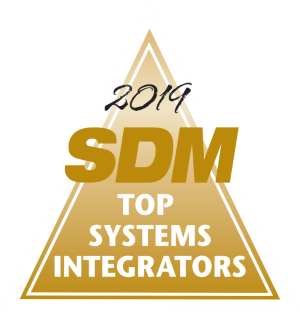TRENDS & INDUSTRY ISSUES
5 Leading Trends in Security Distribution
From trends that promise revenue growth such as the rise of managed services, to those that obstruct progress such as equipment shortages, distributors describe what’s affecting the dynamics with their security integrator/dealer customers in 2023.

One of 40 Snap One partner stores across the U.S., Volutone serves integrators in the Las Vegas area with an expanded product line, same-day availability, expert support and demo days. // IMAGE COURTESY OF SNAP ONE
In the security product distribution business, supply chain disruptions and product price increases still remain among the industry’s primary concerns, as they have for the last few years. But while product delays and shortages have improved somewhat, and distributors and security integrators are seeking any and all remedies to higher costs, several other trends that are impactful to security integrators are also in play. Some are even changing the dynamics of traditional distribution.
In addition to trends that may be having a negative effect on security integrators, such as product availability, distributors recently identified some positive trends, too, such as: the rise of managed services/security as a service; the effect of emerging technologies; demand from certain sectors such as multi-unit dwelling and applications such as network security; and online purchasing.
The Rise of Managed Services
Recurring monthly revenue (RMR) has become a growing revenue model in the security industry, and it isn’t only being generated by conventional alarm monitoring anymore. RMR-based growth is now also fueled by managed services and security-as-a-service.
“Instead of traditional hardware purchases, many companies are now moving to offering subscription-based services for security solutions,” says Brittany Board, director of technology partners at PSA, Westminster, Colo. “This shift is driven by the benefits of steady and predictable income streams for both manufacturers and integrators.”
Such services proffer benefits for all parties, especially the end customer. Selling managed services allows integrators to provide customers with ongoing support, maintenance and monitoring, in addition to cloud-based solutions such as storage. This enhances the overall customer experience and ensures long-term customer loyalty, Board believes.

As a result of this trend, she says, PSA has been proactive in identifying manufacturers that offer managed services and cloud-based security solutions. PSA is helping integrators adapt their business models to include these offerings by providing training and support for subscription-based solutions.
Wesco works in partnership with its top suppliers to continually expand its portfolio to include the top cloud-based security solutions for VSaaS, as well as VMS, access control-as-a-service, and industrial IoT solutions that improve upon existing security solutions to create end-to-end smart solutions, says Tara Dunning, vice president, global security strategy and sales at Wesco, Pittsburgh.
“As we continue to see greater availability and adoption of cloud-based solutions, we focus on training our sales organization and utilizing our technology and support services team to educate our customers on best practices and selecting the right solutions for their needs,” Dunning says.
Snap One’s portfolio includes advanced security systems, surveillance cameras, access control devices, and others — all seamlessly integrated with cloud-based technology, says Nathan Porter, executive vice president of operations at the Charlotte, N.C.-based distributor.
“These products provide robust security features, remote monitoring capabilities, and flexible scalability. In addition to our product offerings, we provide exceptional customer support and technical assistance for all of our cloud-based solutions,” Porter says.
Ben Sultze, director, system integration, locksmith and glass channels at Banner Solutions, St. Louis, says Banner has taken a more proactive position in identifying the right solutions to distribute. This comes as many new cloud-based technologies are being launched in the growing space.
Although he says that many cloud-based solutions aren’t distributed through wholesale, “[Banner Solutions’ team] has the knowledge to work with dealers who are deploying cloud-based solutions and make sure they have the electronic solutions to complete a deployment,” Sultze says.
The Effect of Emerging Technologies
With its built-in, vision-based solutions and IoT-enabled technology, the security camera has become the ultimate sensor, Dunning describes. This has led to increased adoption of, and demand for, security-as-a-service.
“Security technologies of today — machine learning, facial recognition, generative AI, a secure remote workforce, autonomous devices — offer more than traditional physical security and surveillance solutions,” Dunning explains. “They are being utilized to improve operational efficiency, compliance, safety and even revenue.”
Emerging technologies can sometimes change the way the security industry positions itself in the marketplace. Emerging technologies and their expanded use cases require new ways of thinking about security, Dunning believes. At their core, they put pressure on suppliers and distributors to ramp up the training they provide to security integrators. For example, “The shift to data analytics and digitalization emphasizes the need for strong cybersecurity protocols to ensure the security of physical assets; and for more training and education for our customers around data privacy and the ethical and safe use of data,” Dunning says.

Market Demand: Hot Sectors & Applications
Concerns around privacy and data security remain a challenge for the industry to address, says Dennis Holzer, executive director of PowerHouse Alliance, Pittsburgh. “Because of this, networking in particular has gained traction and is another fantastic upgrade opportunity; a homeowner’s security system is not reliable without a connection to the internet that is strong and reliable,” Holzer says.
“As we continue to see greater availability and adoption of cloud-based solutions, we focus on training our sales organization and utilizing our technology and support services team to educate our customers on best practices and selecting the right solutions for their needs.”
— Tara Dunning, Wesco
In addition, PowerHouse Alliance, which continually reviews market trends with its members, asserts that as more consumers prioritize convenience and security, the national consortium will see increased adoption and upgrades of smart home security systems. Based on a Z-Wave Alliance report that shows a vast majority of system owners in the U.S. have added smart home devices after initial purchase, PowerHouse Alliance encourages security dealers to focus on repeat business in this area.
On the commercial side, PowerHouse Alliance is seeing greater customer demand for surveillance in professional installations, as workers return to the office. “The rising growth of multi-dwelling-unit (MDU) properties also contributes to the demand for security in these settings, as well as package-theft solutions,” Holzer says, adding that the company has been able to offer products suited for both types of projects.
Multi-family-housing electronics also have become a priority of Banner Solutions’ distribution model. Helping dealers and integrators complete their projects on time requires inventory of electronic locks and components, Sultze says. “With lead times still extended on some solutions, dealers need options and expertise on how to deploy solutions in the most efficient way,” he says.
Therefore, Banner Solutions has invested in talent on its electronic access control team so that its security dealer and integrator partners can rely on the company’s technical expertise for both electronic and mechanical products, Sultze describes. “Having the best team in the industry is our goal and our team continues to expand their knowledge so they can be a resource for our channel partners,” he says.
Online Purchasing
Perhaps stemming from the pandemic as well as other factors, ADI indicates more of its customers are interested in purchasing products online. The distributor says it continues to make significant investments in its digital footprint and online shopping experience, which rounds out its other purchasing methods and provides security dealer customers with an “omnichannel” experience.
“Our e-commerce site, known as the Digital Branch, gives customers access to the full range of products and services available at ADI,” describes Rob Aarnes, president, ADI Global Distribution, Melville, N.Y. “Since redesigning the site in 2020, we continue to make improvements and add new features and functionality that incorporates feedback from our customers. The implementation of our new Product Information Management (PIM) system transforms how we merchandise our offering and improves the overall online customer buying journey.”

Product Availability
While progress has been made in reducing the backlog and improving supply chain logistics, some product lines may still face challenges in returning to full production, Board at PSA says. Both the supply chain disruption as well as product bans in the security industry have posed significant challenges for security integrators, she says. “Integrators are faced with tough decisions on how to navigate the market and maintain their business operations effectively when they are not able to procure the equipment they are accustomed to purchasing,” she says. “PSA’s response to these challenges reflects a proactive and supportive approach to helping integrators make the best choices for their individual businesses.”
Board says some integrators have chosen to wait for the supply chain issues to be resolved, which requires PSA to maintain excellent communication with all parties about updates on lead times and product availability. “By relaying this information to the integrators, they can make informed decisions about their orders and plan their projects accordingly,” Board says.
For other security integrators that cannot wait or need immediate solutions due to product unavailability, PSA has helped them explore alternative, comparable products that can be substituted.
Commenting on product delays, Porter at Snap One says ocean freight times and costs are moderating to pre-COVID levels, and air freight is seeing a partial recovery. “This allows us to source product closer to the time we need it, rather than planning many months in advance,” Porter says.
“COVID-related factory shutdowns are less common and not having a material impact on manufacturing capacity or delivery dates,” Porter describes. “There’s a general improvement on component availability, with a few pain points where specific chip suppliers are still constrained. The end result is better stocking and supply for 2023 versus 2022.”

“Integrators are faced with tough decisions on how to navigate the market and maintain their business operations effectively when they are not able to procure the equipment they are accustomed to purchasing. PSA’s response to these challenges reflects a proactive and supportive approach to helping integrators make the best choices for their individual businesses.”
— Brittany Board, PSA
Having knowledge of these trends has prompted Snap One to adapt its distribution strategies. “We are leveraging data analytics to gain insights into customer preferences and market trends,” Porter says. “This enables us to adjust product offerings, optimize inventory management, and deliver value-added services that support the success of security dealers and integrators.”
Like other distributors, Wesco has adapted to the ongoing changes in the global supply chain, building resiliency through several initiatives such as ensuring multiple choices for similar solutions, optimizing order-to-delivery time frames, and improving routes from manufacturers to warehouses, among other actions. “Although we are not back to the pre-pandemic levels, we are continuing to see steady improvement on product lead times and availability,” Dunning says.
Sultze at Banner Solutions agrees, saying the distributor is seeing many lead times come back into line from pre-pandemic levels. “There are still a few solutions with extended lead times, but we have kept a healthy backlog of orders with those manufacturers so we can keep a stream of those solutions coming into our inventory.”
Looking for a reprint of this article?
From high-res PDFs to custom plaques, order your copy today!









